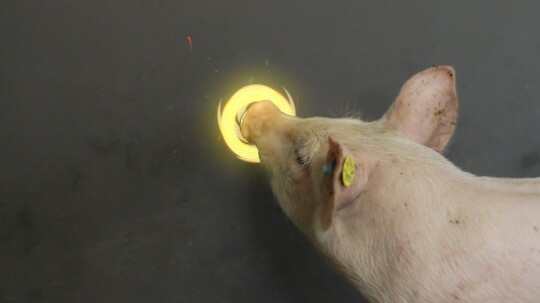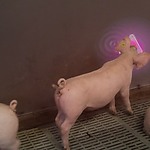For several years, designers and researchers at the Utrecht School of the Arts (HKU) and
Wageningen University and Research Centre (Wageningen UR) have been working on a computer game that enables pigs and people to interact and play together. The human player can control the projection of light on the pigpen’s wall via his iPad. It’s the human player’s goal to capture and retain the naturally curious pig’s attention, so as to encourage the pig to move past a series of targets.
Pigs like play, too
It’s not only people that like to play. Pigs do, too. Studies of pig cognition have shown pigs to have well-developed, large brains. In crowded conditions, pigs are prone to stress and boredomrelated behaviour. Since 2001, European legislation has made it compulsory for pig farmers to provide entertainment in the pens to combat boredom, aggression, and tail biting amongst pigs. In order to meet the regulations, farmers have been experimenting with simple toys such as balls, chains, and ropes. They are social, playful animals and their cognitive abilities make them capable of mastering simple computer games. In practice however, it proves to be difficult to provide the animals with an adequate challenge.
Over the past year, designers Kars Alfrink, Irene van Peer, and Hein Lagerweij (all affiliated with the HKU research group Creative Design for Playful Impact), philosopher Clemens Driessen of Wageningen University, and animal welfare specialist Marc Bracke of Wageningen UR Livestock Research rose to the challenge and have been working on a computer game for pigs. Their aim is two-fold: they want to fulfil the pig’s need to play, and in the process, attempt to establish a different relationship between pigs and humans.
Co-designing with pigs
Pig farmers and their pigs have been closely involved in the design process. They have been helping to create the game by responding to different elements of the game throughout the
test phase. As experimentation progressed, the designers found out that pigs are actually
very interested in the light effects that accompany the video imagery and make an effort to
follow the light with their snouts. This discovery inspired the current set-up of the game in which a human player controls the light effects, which will then capture the naturally curious
pig’s attention, who will be triggered to follow the light towards a series of targets.
Connecting humans and animals
In the process of prototyping, the project team continuously attempts to maximise the positive impact of the game on pig welfare. Although the real value of this type of “pig entertainment” is far from clear, Clemens Driessen’s research focuses on ways in which the development of new technologies can be used to resolve some aspects of the societal debate on animal welfare. Moral views on animal welfare might change over time as a result of the effect that new technologies might have on farming styles and how we understand these. In the process, a computer game provides a playful way of finding out what is interesting entertainment for pigs and the role that people may play in this regard. The field
of human and animal interaction by means of information technology is in its early stages worldwide, but it provides opportunities for forging relationships with animals in new ways, while learning new things about the cognitive capacities of both animals and people.
Pig Chase is being developed as a design research tool by the Utrecht School of the Arts and Wageningen University.


Leave a comment